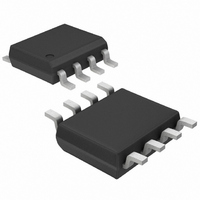MAX295CSA+ Maxim Integrated Products, MAX295CSA+ Datasheet - Page 6

MAX295CSA+
Manufacturer Part Number
MAX295CSA+
Description
IC FILTER LOWPASS 8-SOIC
Manufacturer
Maxim Integrated Products
Datasheet
1.MAX291CSA.pdf
(10 pages)
Specifications of MAX295CSA+
Filter Type
Butterworth, Lowpass Switched Capacitor
Frequency - Cutoff Or Center
25kHz
Number Of Filters
1
Max-order
8th
Voltage - Supply
4.75 V ~ 11 V, ±2.375 V ~ 5.5 V
Mounting Type
Surface Mount
Package / Case
8-SOIC (3.9mm Width)
Number Of Channels
Single
Cutoff Frequency
50 KHz
Supply Voltage (max)
11 V
Maximum Operating Temperature
+ 70 C
Minimum Operating Temperature
0 C
Mounting Style
SMD/SMT
Supply Voltage (min)
4.75 V
Lead Free Status / RoHS Status
Lead free / RoHS Compliant
Lowpass Butterworth filters such as the MAX291/
MAX295 provide maximally flat passband response, making
them ideal for instrumentation applications that require mini-
mum deviation from the DC gain throughout the passband.
Lowpass Bessel filters such as the MAX292/MAX296
delay all frequency components equally, preserving the
shape of step inputs, subject to the attenuation of the high-
er frequencies. They also settle faster than Butterworth fil-
ters. Faster settling can be important in applications that
use a multiplexer (mux) to select one signal to be sent to
an analog-to-digital converter (ADC)—an anti-aliasing filter
placed between the mux and the ADC must settle quickly
after a new channel is selected by the mux.
The difference in the filters’ responses can be observed
when a 3kHz square wave is applied to the filter input
(Figure 1, trace A). With the filter cutoff frequencies set at
10kHz, trace C shows the MAX291/MAX295 Butterworth
filter response and trace B shows the MAX292/MAX296
Bessel filter response. Since the MAX292/MAX296 have a
linear phase response in the passband, all frequency
components are delayed equally, which preserves the
square wave. The filters attenuate higher frequencies of
the input square wave, giving rise to the rounded edges at
the output. The MAX291/MAX295 delay different frequen-
cy components by varying times, causing the overshoot
and ringing shown in trace C.
8th-Order, Lowpass,
Switched-Capacitor Filters
_____________________Pin Description
6
_______________Detailed Description
8-PIN
1
2
3
4
5
6
7
8
_______________________________________________________________________________________
8, 9, 10,
16-PIN
1, 2, 7,
15, 16
11
12
13
14
3
4
5
6
OP OUT
OP IN-
NAME
GND
OUT
CLK
N.C.
V+
V-
IN
No Connect
Clock Input. Use internal or
external clock.
Negative Supply pin. Dual
supplies: -2.375V to -5.500V.
Single supplies: V- = 0V.
Uncommitted Op-Amp Output
Inverting Input to the uncommit-
ted op amp. The noninverting op
amp is internally tied to ground.
Filter Output
Ground. In single-supply oper-
ation, GND must be biased to
the mid-supply voltage level.
Positive Supply pin. Dual sup-
plies: +2.375V to +5.500V. Single
supplies: +4.75V to +11.0V.
Filter Input
FUNCTION
The MAX291/MAX295 give more attenuation outside the
passband. The phase and frequency response curves in
the Typical Operating Characteristics reveal the differences
between the two types of filters.
MAX291/MAX292/MAX295/MAX296 phase shift and gain
do not vary significantly from part to part. Typical phase
shift and gain differences are less than 0.5% at the corner
frequency (F
The MAX291/MAX292 operate with a 100:1 clock to corner
frequency ratio and a 25kHz maximum corner frequency,
where corner frequency is defined as the point where the
filter output is 3dB below the filter’s DC gain. The
MAX295/MAX296 operate with a 50:1 clock to corner fre-
quency ratio with a 50kHz maximum corner frequency.
The 8 poles provide 48dB of attenuation per octave.
Most switched-capacitor filters are designed with biqua-
dratic sections. Each section implements two filtering
poles, and the sections can be cascaded to produce high-
er-order filters. The advantage to this approach is ease of
design. However, this type of design can display poor sen-
sitivity if any section’s Q is high.
An alternative approach is to emulate a passive network
using switched-capacitor integrators with summing and
scaling. The passive network can be synthesized using
CAD programs, or can be found in many filter books.
Figure 2 shows the basic ladder filter structure.
A switched-capacitor filter that emulates a passive ladder
filter retains many of its advantages. The filter’s com-
ponent sensitivity is low when compared to a cascaded
biquad design because each component affects the entire
filter shape, not just one pole pair. That is, a mismatched
component in a biquad design will have a concentrated
Figure 1. Bessel vs. Butterworth Filter Responses
Corner Frequency and Filter Attenuation
A: 3kHz INPUT SIGNAL
B: MAX292 BESSEL FILTER RESPONSE WITH F
C: MAX291 BUTTERWORTH FILTER RESPONSE WITH F
A
B
C
C
).
TIME (200µs/div)
Background Information
o
= 10kHz
o
= 10kHz










